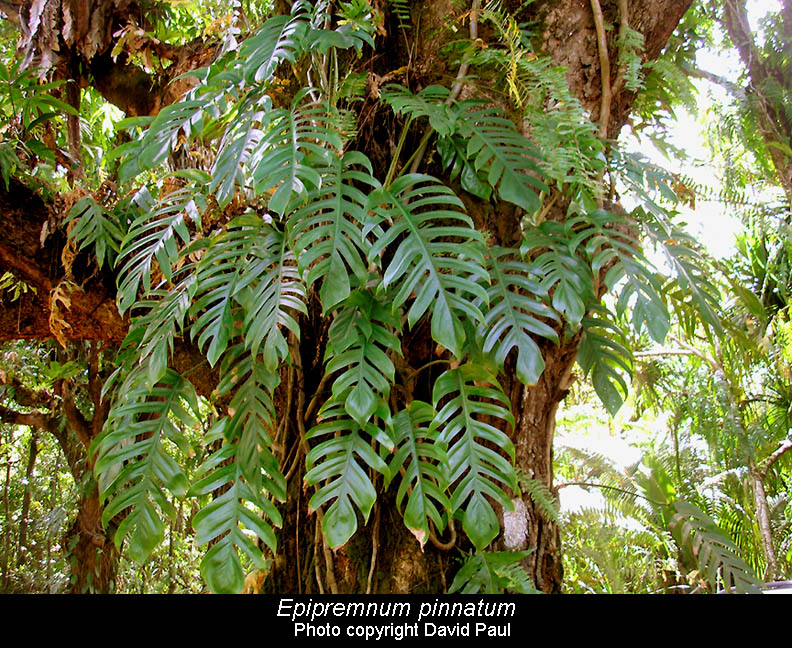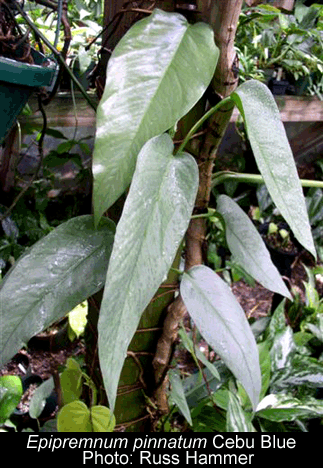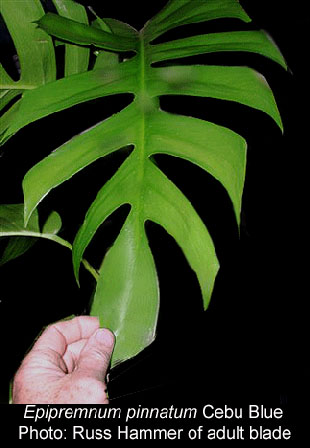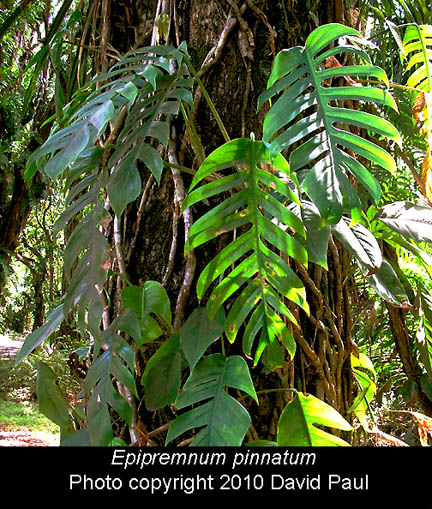![]()
Aroids and other genera in the Collection
Take the Tour Now?
Orchids
The
Exotic Rainforest
Plants in
the Exotic Rainforest Collection
Epipremnum
pinnatum
(L.) Engl.

Epipremnum
pinnatum (L.) Engl.
Synonyms:
Epipremnum angustilobum, Epipremnum elegans,
Epipremnum merrillii,
Epipremnum mirabile, Monstera dilacerata, Monstera pinnata, Pothos
aurea,
Pothos pinnatus,
Rhaphidophora aurea, Rhaphidophora cunninghamii, Rhaphidophora laciniata,
Rhaphidophora lovellae, Rhaphidophora pinnata, Scindapsus pinnatus
and others
Our juvenile specimen shown below is a natural variation known as Cebu Blue
Not Epipremnum aureum (Golden Pothos)
Click this link for a description
 Many people confuse Epipremnum pinnatum
with several Monstera species along with another commonly
collected species: Epipremnum aureum. The latter
is commonly known as "Golden Pothos", "Devil's Ivy", and other
names. The fourth photo on this page is the juvenile
form of Epipremnum pinnatum while the mid adult and adult specimens look very different.
In addition, several Monstera
species such as Monstera dilacerata were originally placed in the
genus Epipremnum in error.
Many people confuse Epipremnum pinnatum
with several Monstera species along with another commonly
collected species: Epipremnum aureum. The latter
is commonly known as "Golden Pothos", "Devil's Ivy", and other
names. The fourth photo on this page is the juvenile
form of Epipremnum pinnatum while the mid adult and adult specimens look very different.
In addition, several Monstera
species such as Monstera dilacerata were originally placed in the
genus Epipremnum in error.
Epipremnum pinnatum has been the source of a great deal of
confusion among both botanists and plant hobbyists. As a
result of the misunderstandings regarding the correct identity of
Epipremnum pinnatum, the confusion has resulted in 24 known synonym names (same
plant, other scientific name). But the adult forms of the two species do not look alike.
Plants can be variable and often change their shapes as they
grow through both morphogenesis and natural variation.
The photo at the top of this page by botanist David Paul shows the species in the adult
form while the photo (right) by Russ Hammer shows the species just
beginning to mature. As an adult, the leaves become both large and pinnate (divided).
Epipremnum pinnatum has become an invasive species in the Wa'a
Wa'a forest in the lower Puna District of Hawaii's big island. The
Puna region is a unique area some describe as a rural community due to
its agricultural activities but the region has been forever changed to
to the invasive nature of species from Southeast Asia and South America
having been introduced. David heads up the Big Island Native Plant
society which involved with Hawaii's island conservation. The society
works to preserve endemic and endangered plants and are also activist
against development which threatens Hawaii's rare island life.
The leaves of Epipremnum pinnatum can be found
"more-or less one at each node"
according to botanist Peter Boyce who
works in
Malaysia.
Although while juvenile, the aroid has a
sagittate leaf blade (arrow shaped), as
Epipremnum pinnatum
 begins to mature the leaves pinnate, looking something
like the frond of a palm and nothing like the juvenile
form. As Epipremnum pinnatum matures the
leaves often contain pin-holes along the mid-rib. Collector Russ Hammer,
commented,
"I always find pin-holes on mine, and in
fact I've thought that it is a typical identifying characteristic for
the species. I see them often on immature leaves as well."
Again, according to Pete Boyce, the apex of the shoot is often covered
with a "matted fibrous material
and the stems can be seen with irregular longitudinal crests".
begins to mature the leaves pinnate, looking something
like the frond of a palm and nothing like the juvenile
form. As Epipremnum pinnatum matures the
leaves often contain pin-holes along the mid-rib. Collector Russ Hammer,
commented,
"I always find pin-holes on mine, and in
fact I've thought that it is a typical identifying characteristic for
the species. I see them often on immature leaves as well."
Again, according to Pete Boyce, the apex of the shoot is often covered
with a "matted fibrous material
and the stems can be seen with irregular longitudinal crests".
According to the published papers of botanist Engler who originally
described the species 1908, the type specimen
of Epipremnum pinnatum was found in the Philippines.
Information on the International Aroid Society website indicates the
distribution of the species is known to be in Bangladesh, India (Andaman
Islands), Myanmar, Thailand, Vietnam, possibly Laos, China (Hainan),
Hong Kong, Taiwan, Japan (Ryukyu Islands, Ogasawara Gunto [Bonin
Islands]), Malaysia (Peninsular, Sabah, Sarawak), Singapore, Indonesia
(Java, Maluku, Nusa Tenggara, Sulawesi, Sumatra), Philippines, Solomon
Islands, Vanuatu, New Caledonia, New Guinea, Australia (Queensland),
Marshall Islands, Belau Islands, Fiji, Tonga, Cook Islands, Western
Samoa and now Hawaii.
Although not native, Epipremnum
pinnatum is also found on numerous Caribbean islands, and in both
Central and South America. Epipremnum species are roughly
the Asian equivalent of the Neotropical genus Monstera found in
Central America, South America, Mexico and the Caribbean, but are not
in the same genus. Plants in the genera Epipremnum and
Monstera along with several other Asian genera known as
Rhaphidophora, Scindapsus and Pothos may appear to be similar but
they are technically different, sometimes due to seed characteristics as
well as where they are found in nature.
 The natural habitat of Epipremnum pinnatum is primarily found in
dense lowland to upper hillside rain forests. The species has even been
observed growing on rocks and on granite. Typically. it is found from
sea level to 1,600 meters in
elevation (near 5,000 feet). Epipremnum pinnatum is an epiphytic climber with large roots.
An epiphyte (ep-a-FIT) is a plant that grows upon another plant. Epipremnum
pinnatum has been observed to climb as high as 15 meters (almost
50 feet) on the side of the host tree. Russ indicatedl, "I have one going up a
large oak tree, it must be 25 or 30 feet high now."
The pre-adult plant (juvenile) usually forms as a
terrestrial grower. Fully adult specimens can be found with stems (canes) of 5mm
to 40mm (less than 1/4 inch to 2 inches) in diameter. It is known
to be a variable species and does not always maintain a singular leaf
appearance.
The natural habitat of Epipremnum pinnatum is primarily found in
dense lowland to upper hillside rain forests. The species has even been
observed growing on rocks and on granite. Typically. it is found from
sea level to 1,600 meters in
elevation (near 5,000 feet). Epipremnum pinnatum is an epiphytic climber with large roots.
An epiphyte (ep-a-FIT) is a plant that grows upon another plant. Epipremnum
pinnatum has been observed to climb as high as 15 meters (almost
50 feet) on the side of the host tree. Russ indicatedl, "I have one going up a
large oak tree, it must be 25 or 30 feet high now."
The pre-adult plant (juvenile) usually forms as a
terrestrial grower. Fully adult specimens can be found with stems (canes) of 5mm
to 40mm (less than 1/4 inch to 2 inches) in diameter. It is known
to be a variable species and does not always maintain a singular leaf
appearance.
The link attached explains
natural variation and morphogenesis (ontogeny) which are known
scientific subjects.
Once you complete reading this page, please consider reading the
non-technical explanation of the natural changes within plant species.
Some estimates indicate as many as one out of every eight plants known
to science naturally vary within their species. Simply click
this link.Click here.
Aroid expert Julius Boos explained,
"If the plant finds itself
growing up a
support or tree that is not tall enough, and which
does not provide the
necessary conditions for it to fully mature and to reproduce, it may
then begin to send out long shoots with juvenile sized and shaped leaves
that, unlike what may be expected, actually appear to seek out large
dark areas. Thos areas may be a larger or taller tree or rock
cliff. These shoots will then root and begin climbing the larger
structure, producing
larger, normal leaves. This behavior may be a form
of scototrophism, the name of a condition where a plant actually seeks
dark
 rather than light."
rather than light."
The normal form of Epipremnum pinnatum is dark green, however our
juvenile specimen is a natural variation known as "Cebu Blue".
Cebu is a province of the Philippines. The young leaves are
rounded to slightly cordate (heart shaped), but as the species
matures it becomes pinnatifid (palm shaped).
Fenestrations (holes in the leaves) often appear making some collectors confuse Epipremnum pinnatum with the genus Monstera
(see note above). The surface of the leaf is
often a lustrous dark green but may rarely be seen with the slight to intensely blue-green leaf blade.
Of unusual interest, the leaves of Epipremnum pinnatum are used
to the blacken the teeth in some island cultures.
An aroid, E. pinnatum produces a spathe and spadix. The
spathe is not a "flower" but instead a modified leaf. A
mature spathe is considered "canoe shaped" and grows to 15 mm (6 inches). The
spathe's exterior is green to dull greenish yellow while the interior is a dull
yellow or pale green. The fruit berries, which can form along the spadix
once pollinated, are a medium green. The plant's berries contain
seeds once mature.
For more information on the pollination of aroid species,
click this link.
Want to know more
about aroids?
Join the
International Aroid Society:
http://www.exoticrainforest.com/Join%20IAS.html